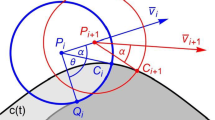Abstract
Many mechanical parts are manufactured by milling machines. Hence, geometrically efficient algorithms for tool path generation, along with physical considerations for better machining productivity with guaranteed machining safety, are the most important issues in milling. In this paper, an optimized path generation algorithm for direction-parallel milling, a process commonly used in the roughing stage as well as the finishing stage and based on an incomplete 2-manifold mesh model, namely, an inexact polyhedron widely used in recent commercialized CAM software systems, is presented. First of all, a geometrically efficient tool path generation algorithm using an intersection points-graph is introduced. Although the tool paths obtained from geometric information have been successful in forming desired shapes, physical process concerns such as cutting forces and chatters have seldom been considered. In order to cope with these problems, an optimized tool path that maintains a constant MRR for constant cutting forces and avoidance of chatter vibrations, is introduced, and verified experimental results are presented. Additional tool path segments are appended to the basic tool path by means of a pixel-based simulation technique. The algorithm was implemented for two-dimensional contiguous end milling operations with flat end mills, and cutting tests measured the spindle current, which reflects machining characteristics, to verify the proposed method.
Similar content being viewed by others
References
M. Held, On the Computational Geometry of Pocket Machining, Berlin: Springer-Verlag, (1991).
N. M. Patrikalakis and T. Maekawa, Shape Interrogation for Computer Aided Design and Manufacturing, Springer-Verlag Berlin Heidelberg New York, (2002).
R. J. Goult and P. A. Shearar, Improving the Performance of Neutral File Data Transfers, Springer-Verlang, New York, (1990).
H. Persson, NC Machining of Arbitrary Shaped Pockets, Computer-Aided Design, 10(3) (1978) 169–174.
A. Hansen and F. Arbab, An Algorithm for Generating NC Tool Path for Arbitrary Shaped Pockets with Islands, ACM Transaction on Graphics, 11(2) (1992) 152–182.
M. Held, A Geometry-Based Investigation of the Tool Path Generation for Zigzag Pocket Machining, Visual Computer, 7 (1991) 296–308.
K. Tang, S. Chou and L. Chen, An Algorithm for Reducing Tool Retraction in Zigzag Pocket Machining, Computer-Aided Design, 30(2) (1998) 123–129.
S. C. Park and B. K. Choi, Tool-Path Planning for Direction-Parallel Area Milling, Computer-Aided Design, 32(1) (2000) 17–25.
M. Manuel and C. A. Rodriguez, Influence of Tool Path Strategy on the Cycle Time of High-Speed Milling, Computer-Aided Design, 35(4) (2003) 395–401.
J. Tlusty, S. Smith and C. Zamudia, New NC Routines for Quality in Milling, Annals of the CIRP, 39(1) (1990) 517–521.
T. R. Kramer, Pocket Milling with Tool Engagement Detection, J. Manufacturing Sys., 11(2) (1992) 114–123.
S. Smith, E. Cheng and C. Zamudia, Computer-Aided Generation of Optimum Chatter-Free Pockets, J. of Materials Processing Technology, 28 (1991) 275–283.
D. Y. Lee, S. J. Kim, S. G. Lee and M. Y. Yang, Incomplete Mesh Based Tool Path Generation, Proceeding of the SMPE Spring Conference 2003, (2003) 844–847.
H. Iwabe, Y. Fujii, K. Saito and T. Kisinami, Study on Corner Cut by End Mill Analysis of Cutting Mechanism and New Cutting Method at Inside Corner, J. of Japan Society of Precision Engineering, 99(5) (1989) 841–846.
M. D. Tsai, S. Takata, M. Inui, F. Kimura and T. Sata, Operation Planning Based on Cutting Process Models, Annals of CIRP, 40(1) (1991) 95–98.
Y. Liu, L. Zuo and C. Wang, Intelligent Adaptive Control in Milling Processes, Int. J. Computer Integrated Manufacturing, 12 (1999) 453–460.
S. C. Kim and S. C. Chung, Robust Cutting Force Control Using Indirect Force and Disturbance Estimation in the End Milling Process, Proceedings of ASPE, 20 (1999) 248–251.
M. Y. Yang and T. M. Lee, Hybrid Adaptive Control Based on the Characteristics of CNC End Milling, Int. J. Mach. Tools Manufact, 42 (2002) 489–499.
Author information
Authors and Affiliations
Corresponding author
Additional information
This paper was recommended for publication in revised form by Associate Editor Dae-Eun Kim
Hyun-Chul Kim received his B.S., M.S. and Ph.D. degrees in Mechanical Engineering from KAIST, KOREA, in 1999, 2001 and 2005, respectively. Dr. Kim is currently a Professor at the School of Mechanical & Automotive Engineering at Inje University in Gimhae, Korea. Dr. Kim’s research interests include CAD/CAM, manufacturing, and precision machining.
Rights and permissions
About this article
Cite this article
Kim, HC. Optimum tool path generation for 2.5D direction-parallel milling with incomplete mesh model. J Mech Sci Technol 24, 1019–1027 (2010). https://doi.org/10.1007/s12206-010-0306-7
Received:
Revised:
Accepted:
Published:
Issue Date:
DOI: https://doi.org/10.1007/s12206-010-0306-7



